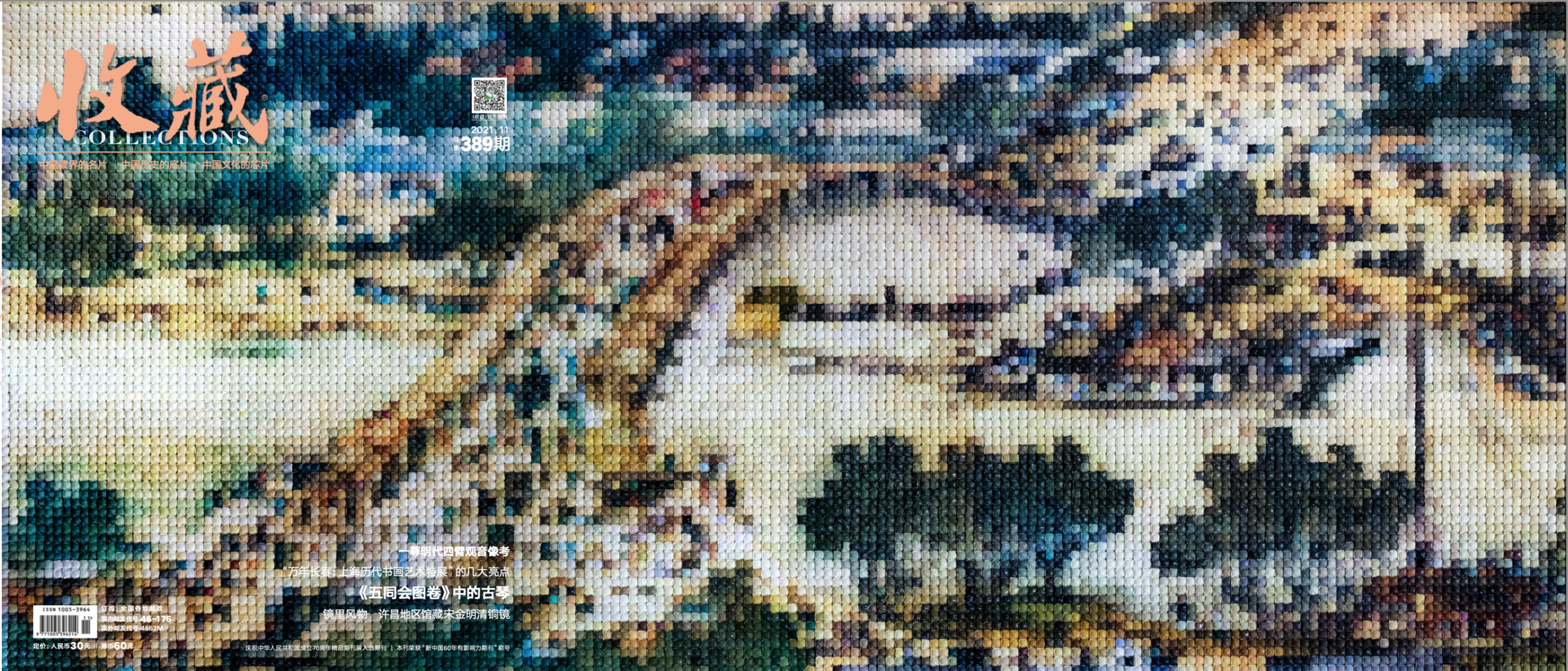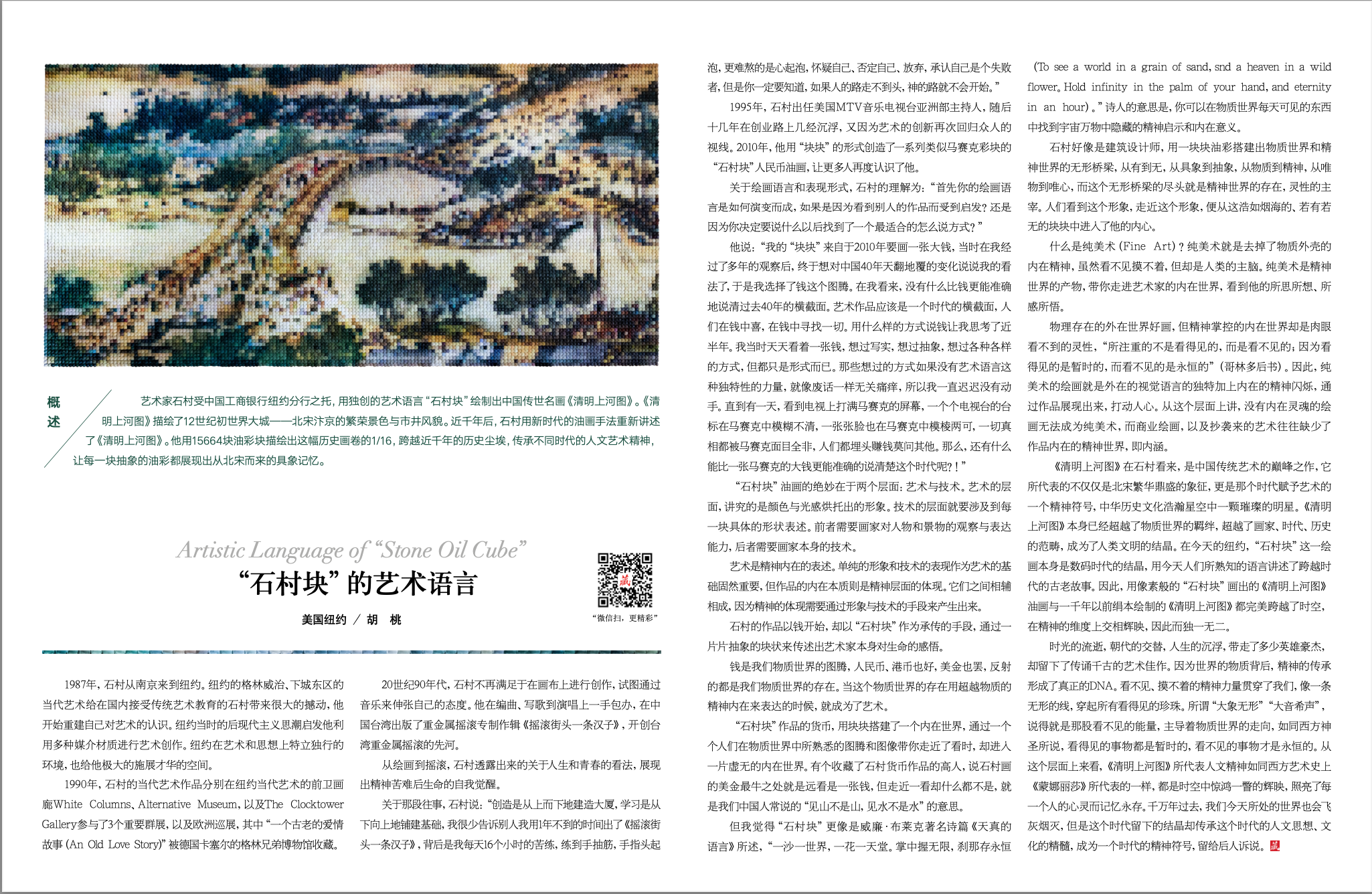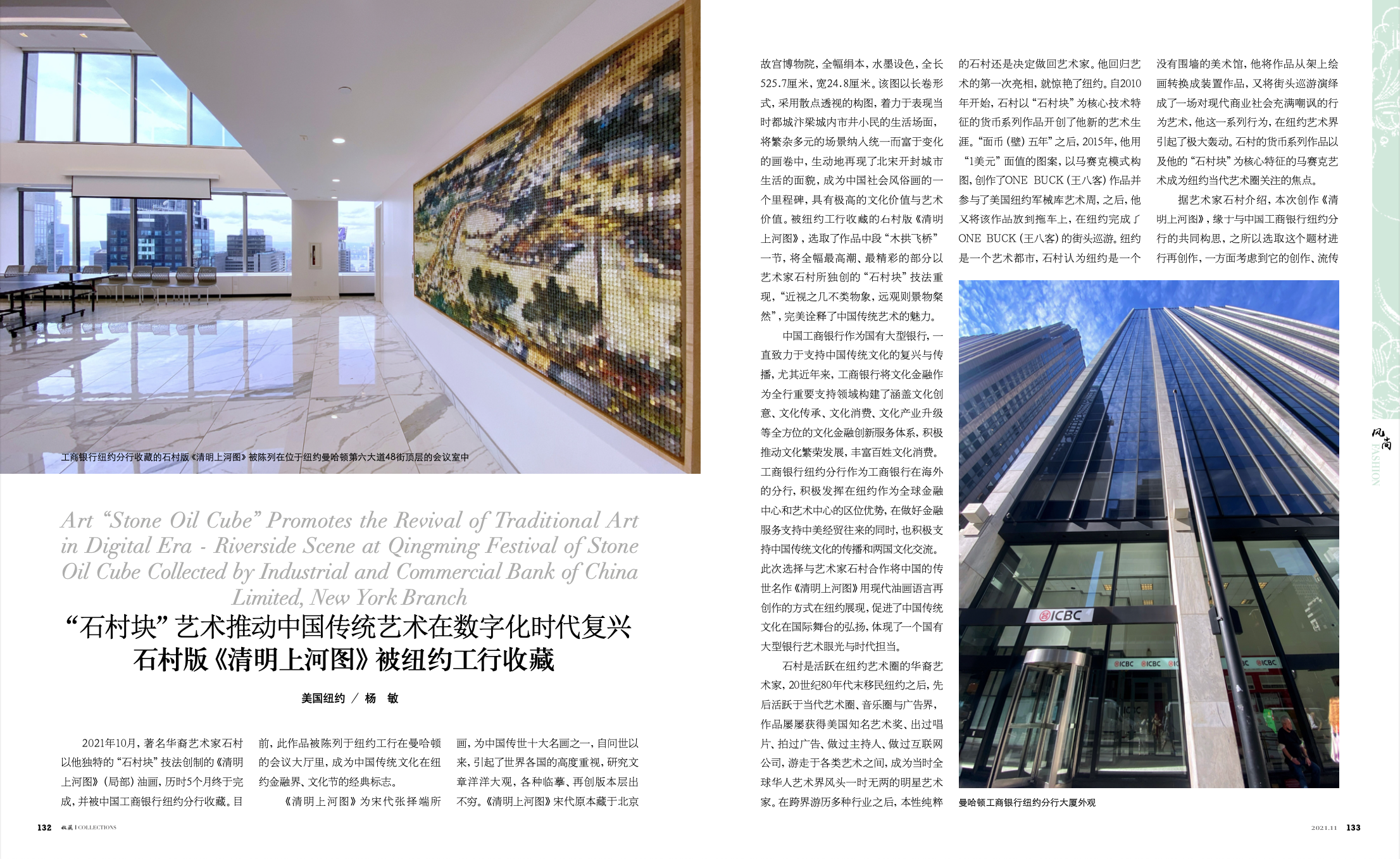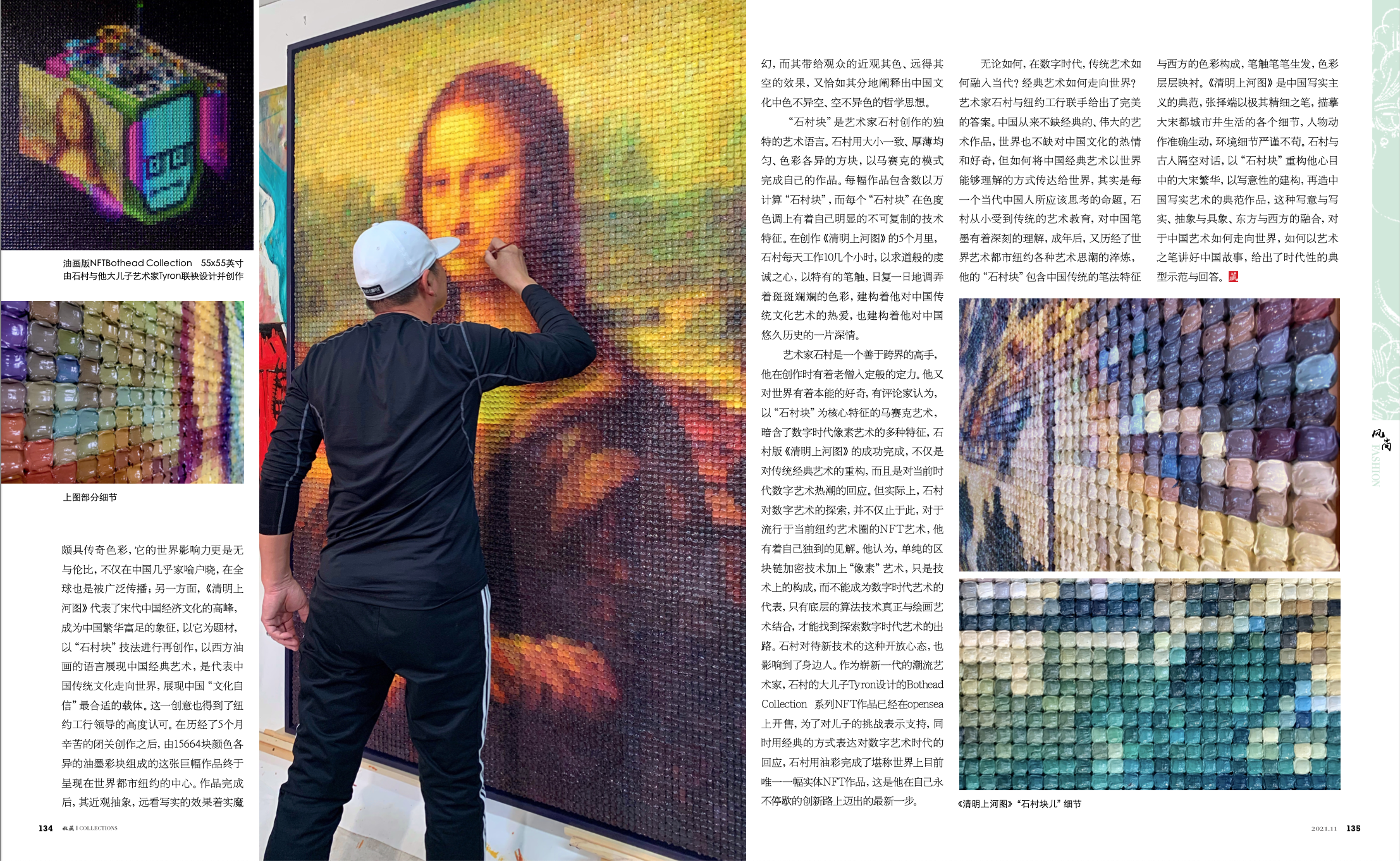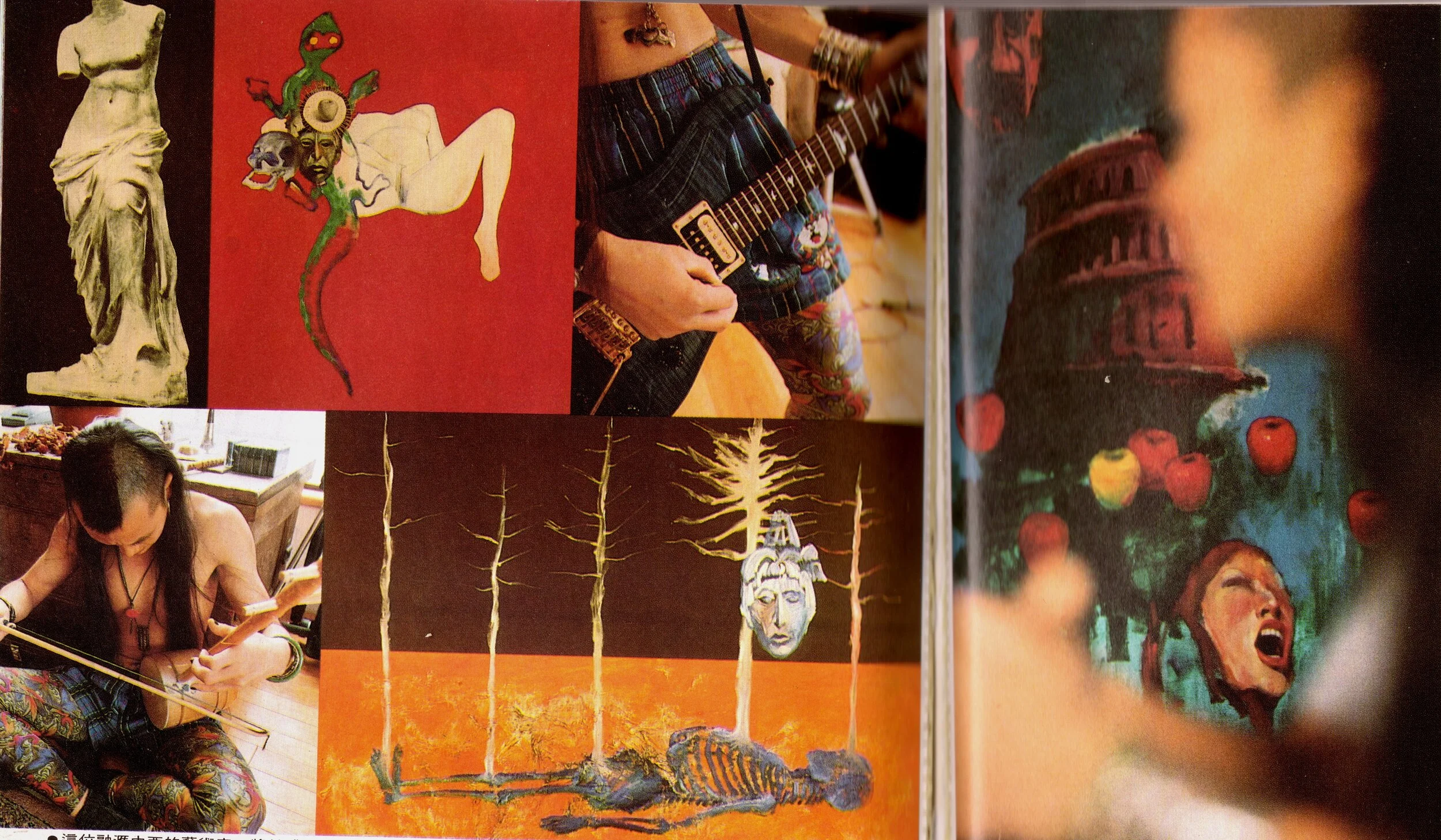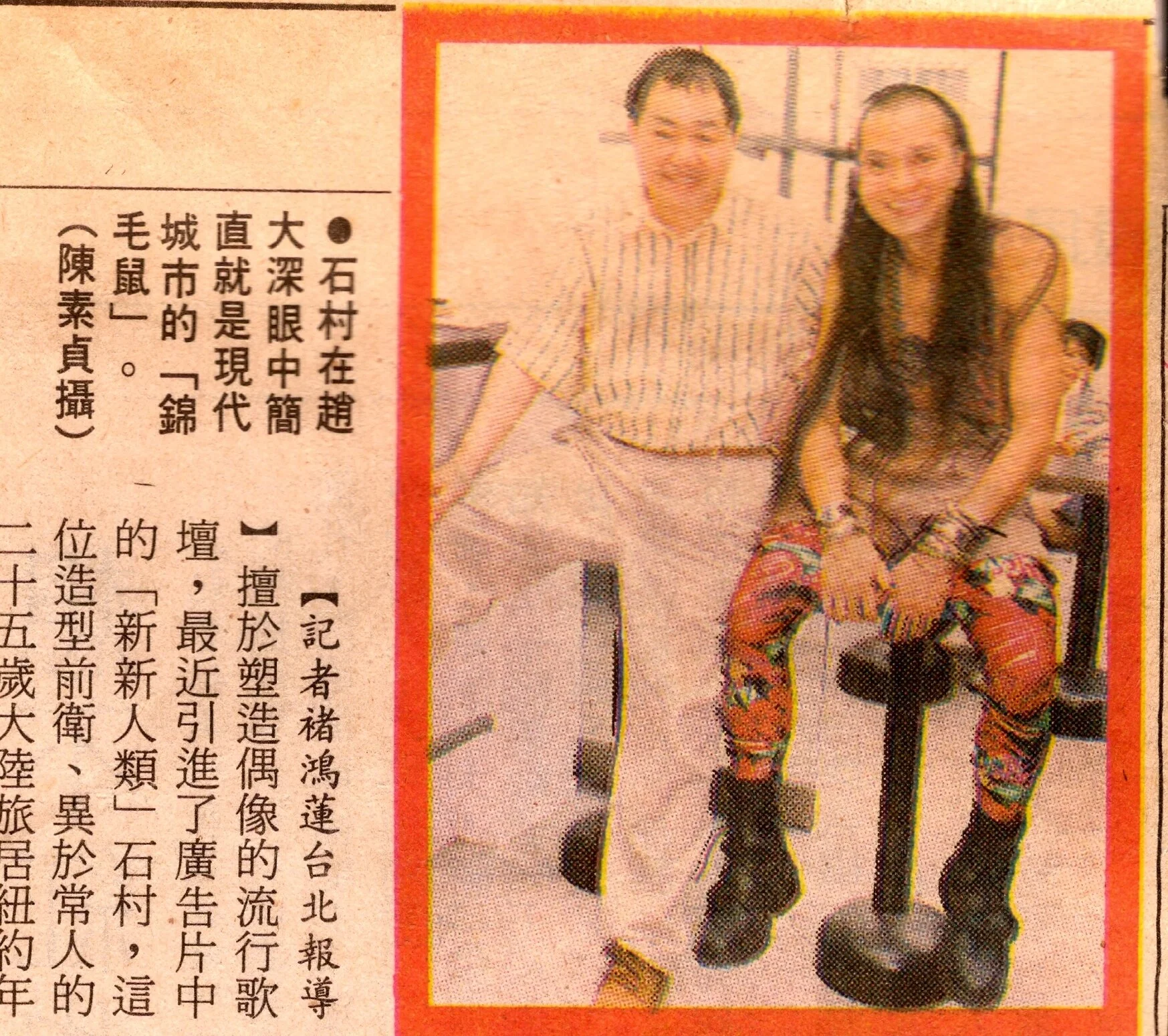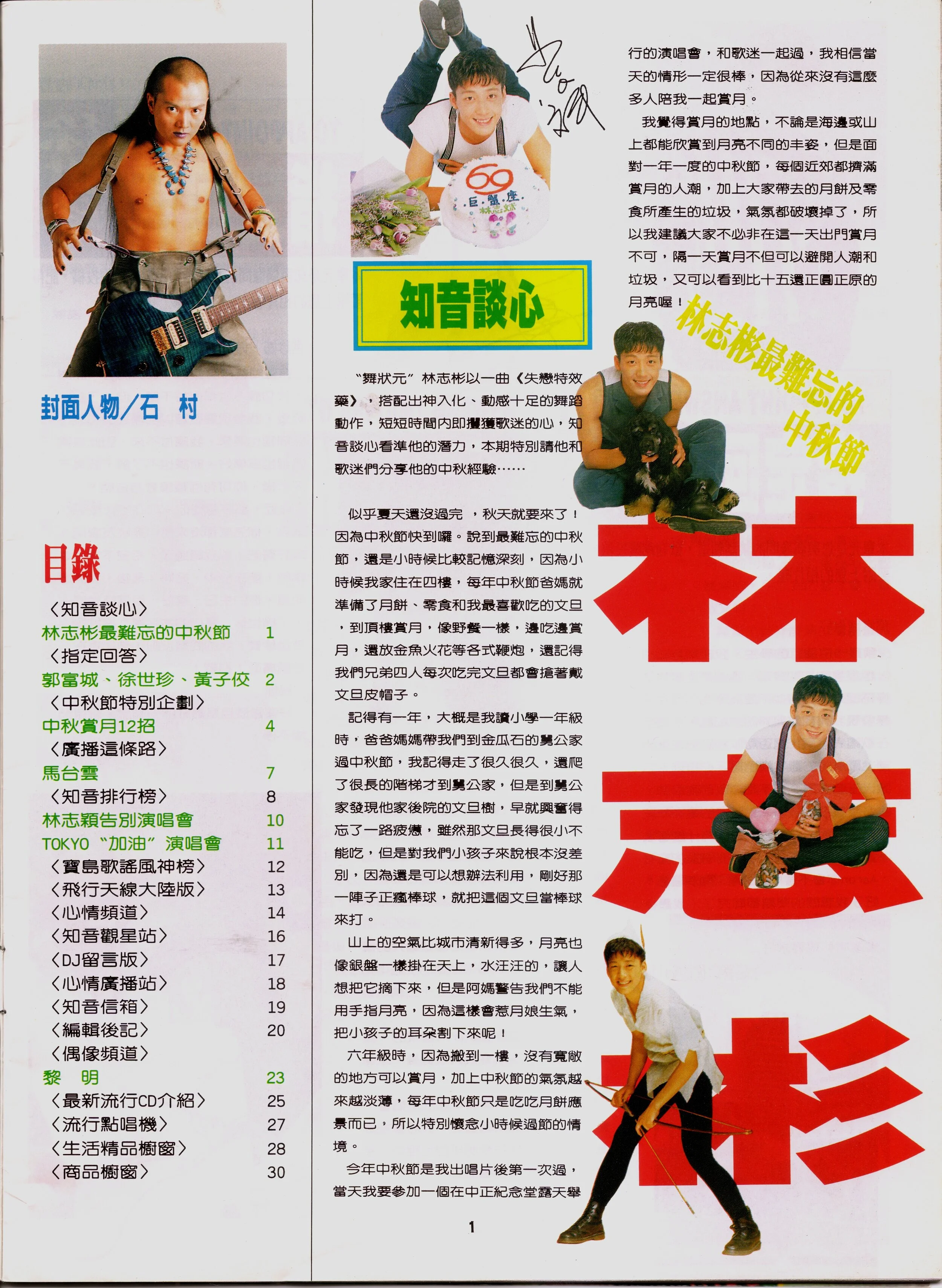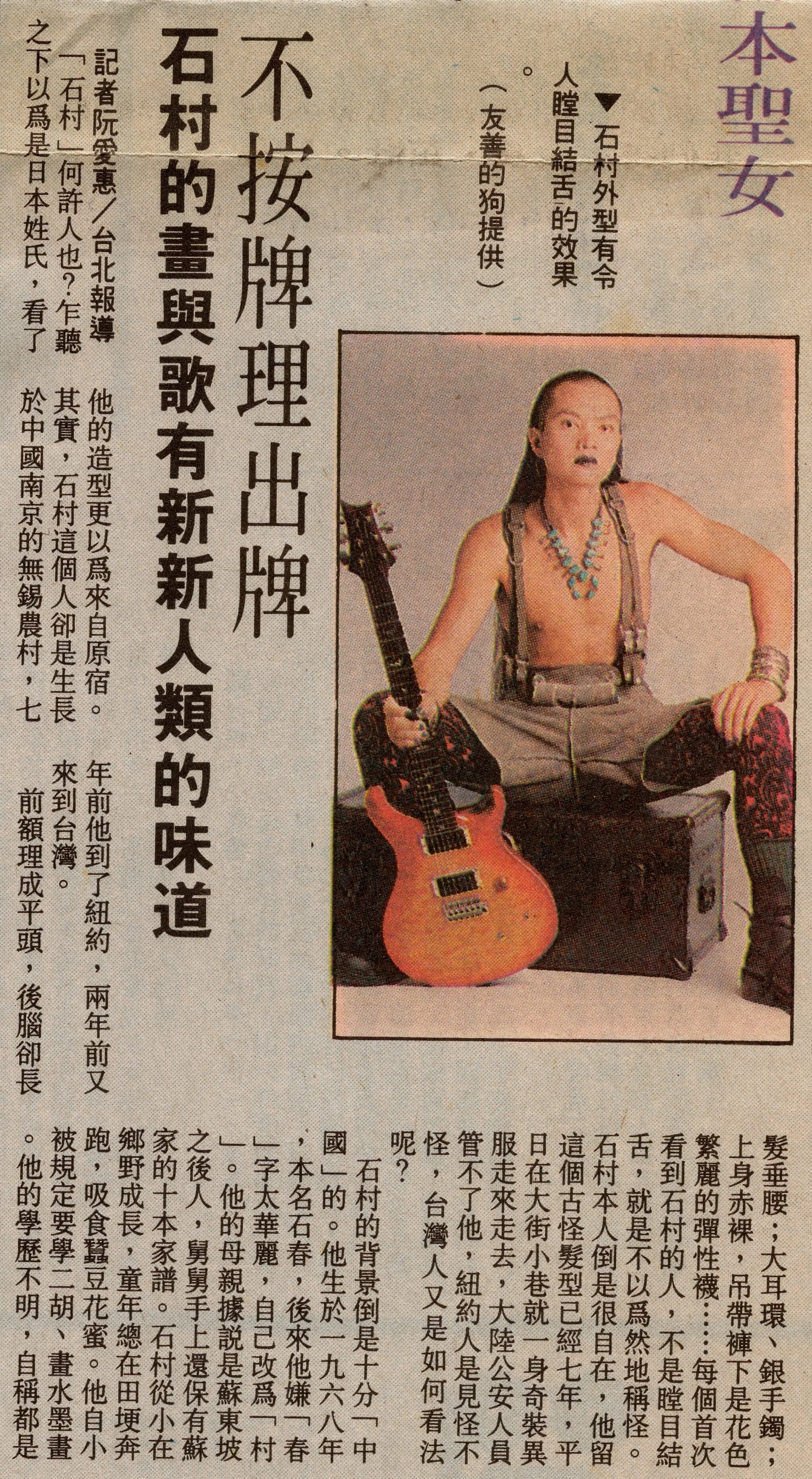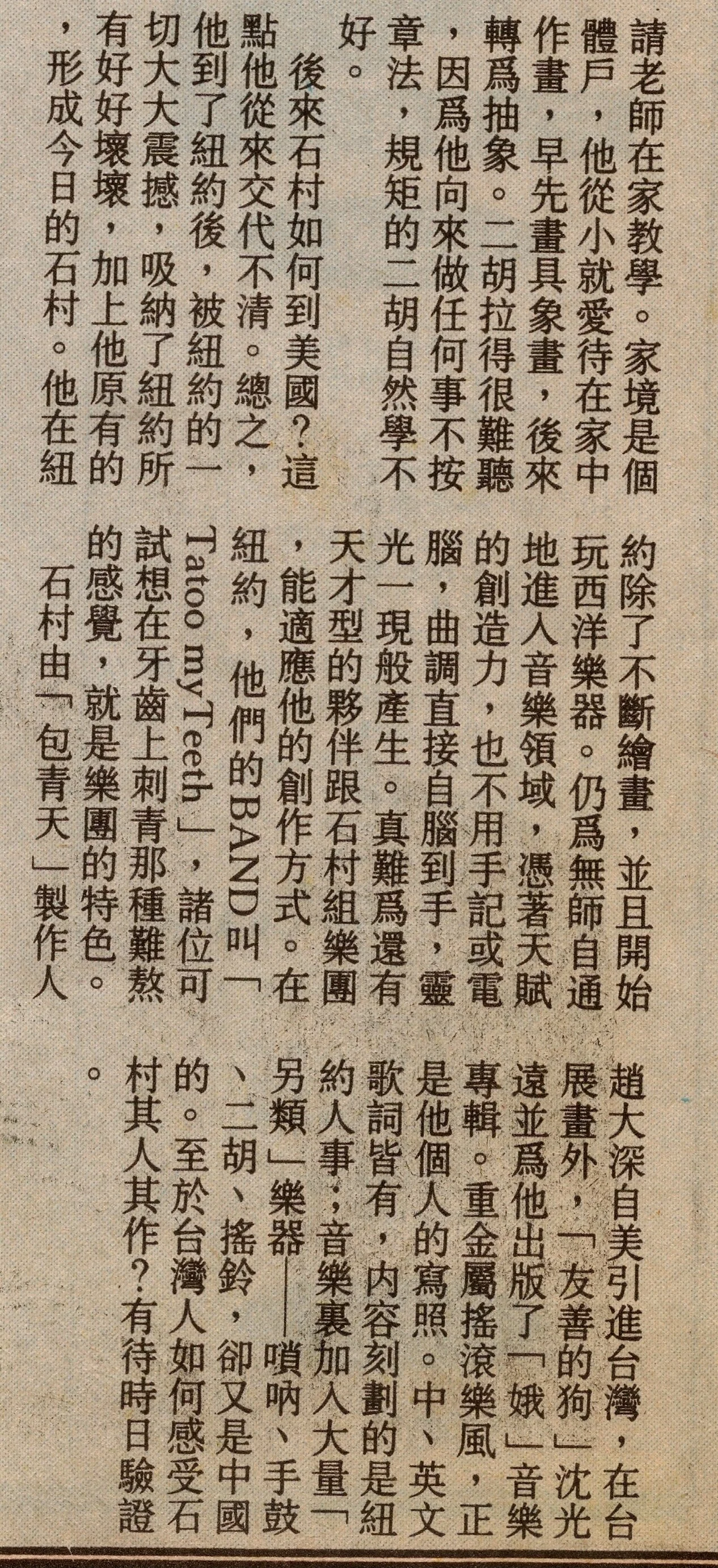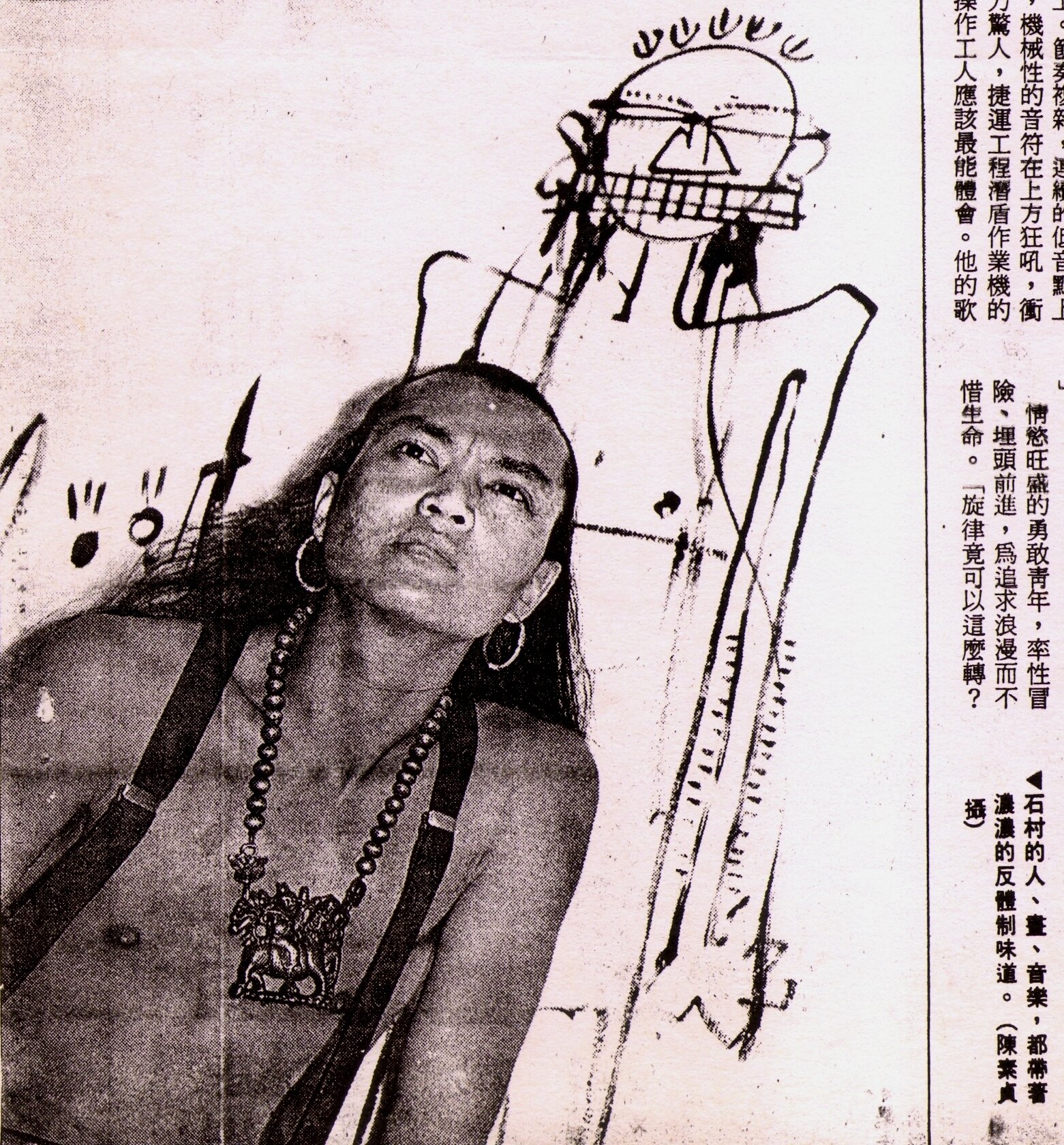Newspaper & Magazine
The Artistic Language of Stone Oil Cube
by Sonia Hu, Collection Magazine, November 2021
Artist Stone Chun Shi was commissioned by the Industrial and Commercial Bank of China's New York branch to create a rendition of the famous Chinese painting "Along the River During the Qingming Festival" using his unique artistic language, "Stone Oil Cube." "Along the River During the Qingming Festival" depicts the prosperous scenes and marketplace atmosphere of Bianjing, a major city of the Northern Song Dynasty in the early 12th century. Over 900 years later, Stone Chun Shi retells the story of "Along the River During the Qingming Festival" using modern oil painting techniques. He used 15,664 oil color cubes to depict one-sixteenth of this historical scroll, transcending nearly a thousand years of history and inheriting the humanistic and artistic spirit of different times, allowing each abstract oil color cube to reveal concrete memories from the Northern Song Dynasty.
The brilliance of "Stone Oil Cube" paintings lies in two aspects: art and technique. On the artistic level, it emphasizes the portrayal of images through color and light. On the technical level, it involves the specific shape and expression of each cube. The former requires the painter's ability to observe and express people and scenes, while the latter requires the painter's own technique.
Art is the expression of one's inner spirit. While the pure depiction of images and the demonstration of techniques are certainly important foundations of art, the intrinsic essence of a work lies in its spiritual dimension. These aspects complement each other, as the manifestation of the spirit requires the means of image and technique to be brought to life.
Stone Chun Shi's works began with money but used the "Stone Oil Cube" as a means of transmission, conveying the artist's own perception of life through a series of abstract cubes.
Money is the totem of our material world, whether it's RMB, Hong Kong dollars, or US dollars, they all reflect the existence of our material world. When the existence of this material world is expressed through a spiritual essence that transcends materialism, it becomes art.
The "Stone Oil Cube" artwork uses currency to build an inner world, taking you closer to familiar totems and images in the material world yet leading you into a void of an inner world. A connoisseur who has collected Stone Chun Shi's currency artwork said that the most amazing aspect of Stone Chun Shi's depiction of US dollars is that from afar, it looks like a banknote, but when you look closely, it turns out to be nothing, which is what the Chinese often say: "Seeing a mountain is not a mountain, and seeing water is not water."
However, I think "Stone Oil Cube" is more like the famous lines from William Blake's poem "Auguries of Innocence": "To see a World in a Grain of Sand, And a Heaven in a Wild Flower. Hold Infinity in the palm of your hand, And Eternity in an hour." The poet means that you can find hidden spiritual revelations and inner meanings in the everyday objects of the material world.
Stone Chun Shi seems like an architect, using oil color cubes to build an invisible bridge between the material world and the spiritual world, from concrete to abstract, from material to spiritual, and from materialism to idealism. At the end of this invisible bridge lies the existence of the spiritual world and the dominance of spirituality. When people see this image and approach it, they enter his inner world through the seemingly intangible cubes, as vast as a sea of smoke.
Fine Art is the inner spirit stripped of its material shell. Although it is invisible and intangible, it is the essence of human creativity. Fine Art is a product of the spiritual world, taking you into the artist's inner realm, allowing you to see their thoughts, feelings, and insights.
It is easy to depict the physically existing external world, but the inner world governed by the spirit is an invisible, intangible essence. "So we fix our eyes not on what is seen, but on what is unseen, since what is seen is temporary, but what is unseen is eternal" (2 Corinthians 4:18). Therefore, Fine Art painting combines unique external visual language with inner spiritual brilliance, and through the artwork, it touches people's hearts. From this perspective, a painting without an inner soul cannot be considered Fine Art. In contrast, commercial art and plagiarized art often lack the inner spiritual world, or the intrinsic value, of the artwork.
In Stone Chun Shi's view, "Along the River During the Qingming Festival" is a pinnacle of Chinese traditional art. It represents not only the symbol of prosperity in the Northern Song Dynasty but also a spiritual symbol of the art endowed by that era, a brilliant star in the vast expanse of Chinese history and culture. The painting itself has transcended the constraints of the material world, the painter, the era, and history, becoming a crystallization of human civilization. Today, in New York, the Stone Oil Cube painting is a crystallization of the digital age, telling the ancient story across time in a language familiar to people today. Therefore, the "Along the River During the Qingming Festival" oil painting created with pixel-like Stone Oil Cubes perfectly transcends time and space, reflecting each other's brilliance on the spiritual dimension and becoming truly unique.
As time passes, dynasties change, and the vicissitudes of life take away many heroes, but they leave behind artistic masterpieces that are celebrated for centuries. Behind the material world, the spiritual inheritance forms the true DNA. The invisible and intangible spiritual force runs through us, like an invisible thread threading all visible pearls. The so-called "the greatest form is without shape, the greatest sound is silence" refers to that invisible energy, which often dominates the direction of the material world. As the Western sacred teachings say, visible things are temporary, while invisible things are eternal. From this perspective, the humanistic spirit represented by "Along the River During the Qingming Festival" is like the "Mona Lisa" in Western art history, both are fleeting glimpses in time and space, yet illuminating the hearts and memories of everyone.
Millions of years will pass, and the world we live in today will eventually fade away. However, the crystallization of this era will inherit the essence of humanistic thought and culture of this time, becoming a spiritual symbol of an era, left for future generations to recount.
"Stone Oil Cube", the anchor point linking traditional painting and future art in the information age?
By Yang Min, Collection Magazine, May 2021, New York, USA
I first knew about the "Stone Oil Cube" before I met the artist Stone Chun Shi. It was around the winter of 2017 when, at a well-known auction in Beijing, I was suddenly attracted to a Buddha oil painting. The entire work was densely arranged with regular and meticulous squares. When viewed closely, it consisted of squares of varying colors and uniform size, while from a distance, a compassionate Buddha appeared within. "The brushstrokes are very casual, hardly resembling objects when viewed up close, but the scenery is splendid from a distance, with a sense of deep emotion and distant thoughts, like seeing a different realm," this scene perfectly describes Dong Yuan's "Falling Glow" as described by Shen Kuo in "Dream Creek Essays" during the Northern Song Dynasty. Amid the hustle and bustle of the auction, this work caught my eye, and I remembered the name Stone Chun Shi. Later, I learned that the "Buddha · Lotus" sold for a high price of nearly one million yuan. I was surprised that it was so expensive, and even more so when, a few years later, my connection with the artist Stone Chun Shi continued in New York. On a chance occasion, a friend introduced me to Stone Chun Shi, and I visited his studio. After several in-depth conversations, I finally connected the abstract "Stone Oil Cube" with the "concrete" Stone Chun Shi.
What is the "Stone Oil Cube"? The Stone Oil Cube is a unique artistic language created by the artist Stone Chun Shi. Stone Chun Shi uses uniform-sized, evenly thick, and colorful squares in a mosaic-like pattern to complete his works. Each piece contains tens of thousands of "Stone Oil Cubes," each with its distinct color and tone characteristics. With a devout heart, Stone Chun Shi manipulates the colorful colors day after day with his unique brushstrokes, constructing his masterpieces. Who is "Stone Chun Shi"? Stone Chun Shi is not a quiet person. He has been painting since childhood and came to New York in 1987. He has worked as an architect, rock singer, advertising star, poet, painter, TV show host, and technology company owner in New York, Taipei, and Beijing. Which of these dazzling career changes is the real "Stone Chun Shi"? After experiencing the world, Stone Chun Shi picked up the brush again. Since I first laid eyes on Stone Chun Shi's work a few years ago, I have always felt that he is not a simple person, as there is always something special in his work that keeps me coming back. Is it a unique form? The ever-changing colors? Contemporary concepts? Or the philosophy hidden behind the colorful colors? When you face Stone Chun Shi, stripped of various professional identities, you will find that he has abandoned the hustle and bustle and chosen simplicity. Whether it is the ironic color currency series or the fashionable Marilyn Monroe series, Stone Chun Shi sits calmly in front of the painting like an old monk in meditation, deconstructing the times and classics one by one, constructing his unique art.
At the beginning of 2021, under the influence of the global epidemic, encrypted art began to flourish, and digital art became a new thing where art and technology coexist. Artist Beeple's non-fungible token (NFT) work "Everydays—The First 5000 Days" sold for nearly 69.34 million US dollars (equivalent to 450 million RMB) at Christie's auction in mid-March. Some critics believe that compared to the difficult-to-understand "pixel art," Stone Chun Shi's currency works series constructed with "Stone Oil Cubes are undoubtedly more representative of the characteristics of information age art in terms of formal language and contemporary concepts. Stone Chun Shi has a unique and clear understanding of encrypted art. He believes that as times change, the logic and extension of art also change, but the essence of art has never changed. Whether it is the Pop Art of a commercial society or the encrypted art of the information age, artistic expression must reflect the contemplation of the times and the philosophy of art. In my understanding, Stone Chun Shi's works are based on the relationship between "color and emptiness." Color represents all things in the world, while emptiness signifies spiritual self-awareness. Stone Chun Shi's works, when viewed closely, display splendid colors in each cube, yet do not cling to any particular object. From a distance, the colors fade, and the scenery emerges. When viewed closely, the colors are present but empty, while from afar, the colors are faint but present. "Color is not different from emptiness, emptiness is not different from color, color is emptiness, emptiness is color." Regarding the world, all things, and art, only by breaking the attachment to "color" can we find the self-awareness and self-enlightenment of the heart.
French literary critic Roland Barthes believes that when a work is completed, the author disappears because the right to interpret the work belongs to each reader. Stone Chun Shi uses the most traditional method to create art forms and concepts that best suit the information age. Perhaps the "Stone Oil Cube" is the real "anchor point" linking traditional painting and future art? On this point, even after completing this interview, I still have no answer. Perhaps the real discovery of the "Stone Oil Cube" should be left to the future, to time, and to those with insight and the ability to think.
People Magazine
The People Magazine Taiwan Edition interviewed Stone in 1994 with reference to how his passion for art led his journey from mainland China to New York, and eventually Taiwan.
Legendary People section, October 1994
Shi Cun, A Spokesperson for New New Generation? ARTouch
Stone appeared on Taiwan’s leading art magazine ARTouch when he had his solo shows at two prodigious art galleries in 1994.
Shi Cun, An Explorative Soul
by Zhu Yajun, Crown Magazine, 1994, Taipei
Love is a mask of death, death is a prelude to life, unrestrained and wild rock 'n' roll, and dazzlingly bizarre paintings. He strides confidently in a pair of leopard-print boots.
The scene unfolds: a man on the streets of New York with rebellious punk long hair, large earrings, and suspender shorts. His bare upper body and arms are adorned with several necklaces and bracelets. Under the bright sun, he strides confidently in a pair of leopard-print boots accompanied by heavy metal rock music, chaotic canvases, and colorful street scenes. He declares: "I want to paint like this; I want to create my music like this; I don't want to tell others what they should do!" This is a recent visually stunning advertisement for a brand of Oolong tea. He is Stone Chun Shi, an artist in New York who paints, plays music and stays true to himself.
Surprisingly, you can see him dressed in punk attire on the streets of characterless Taipei, giving the illusion of stepping into the world of the advertisement.
Instead of calling it an advertisement, it would be more accurate to call it a documentary. Because that's him - his music, his paintings, his narration. It's all him.
Born in Nanjing and raised in rural Wuxi, Stone Chun Shi also had a childhood running through the fields. Beside the field ridges were abundant purple and white fava bean flowers dancing in the wind. They would pluck the flowers and eagerly suck the honey-like nectar from them. As a child, he studied the erhu (a traditional Chinese string instrument) and traditional Chinese painting. However, at that time, mainland China was isolated in terms of information. Music was either Peking opera or revolutionary songs, so he gave up the erhu and focused on painting. He thought the world was just like this, painting and painting, until seven years ago when he came to the dreamlike city of New York. "Everything is different in New York. The cultural shock is huge. For two years, I hardly painted at all. I just experienced and felt it." Stone Chun Shi says: New York is a battlefield, and fantasies are unnecessary! Only by doing your own thing well can you be better than others! He started painting again, and his exhibitions grew larger and larger, even being shown at "The Clock Tower" and "Alternative Museum." The New York art scene recognized the achievements of this young painter.
However, this did not satisfy Stone Chun Shi. An artist's explorative soul and dual personality tore at his heart. He knew there was more to him than that. "Painting is a very quiet language, but I have more surging thoughts inside me that I must express loudly." So, he found rock music, immersed himself in wild music, and aimed to become a rock star! "What is rock music? It's not only music but also a way of life that closely fits my life essence!" He says life is about constantly taking risks, and through these risks, we can explore various possibilities! If you want to do something, do it quickly! "What I fear most in my life is not taking risks, but one day when I am old and gray-haired, sitting in a rocking chair and reminiscing, suddenly regretting that there was something I always wanted to do when I was young but never accomplished, and now I am powerless to do it. How terrible that would be!"
Wild rock music flows through our conversation, listening to his passionate singing: "Twinkle, twinkle, bright and shining, put on your mask, love is a mask of death, death is a prelude to life..." Looking at his bizarre paintings, red, blue, and green skulls, female bodies, crosses, and monkey heads, it's hard not to want to explore his inner world. "My paintings may seem intense and violent, but I'm actually very quiet when I'm painting, and I don't even listen to music. Even when I'm burning, carving, or using various tools to manipulate the image, my inner self is very peaceful. The same goes for my music; it's heavy, but the melody is very expressive." Stone Chun Shi says he does not advocate excessive emotionalism in art. He likes the calm approach of Chinese literati, even for a wild cursive painting; it is gentle and progressive.
Shi Chun Took Over Taiwan With His “Storm”
—interview by China Times, 1994
Shi Chun (Stone) was interviewed by Taiwan’s leading newspaper China Times in 1994 which described his multiple talents in the aspects of art and rock music.
